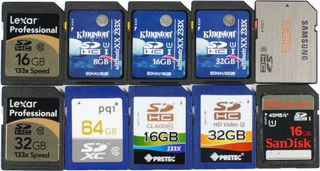10 SDXC/SDHC Memory Cards, Rounded Up And Benchmarked
The latest flash-based SD memory cards with UHS-I deliver up to 63 MB/s throughput. Users who want to exploit that performance need to pay attention to a few details, like making sure they upgrade to a USB 3.0 card reader. Which card is the fastest?

High-Speed And High-Capacity SD Memory Cards Tested
SD memory cards have been on the market since late 2001, and nowadays they can be considered the storage backbone for the entire consumer electronics market. Devices like GPS units, tablet PCs, and digital cameras rely on SD memory cards.
It’s certainly appropriate to call SD cards the medium of our digital life when we're away from the PC, and we decided to look at some of the latest offerings for advanced users.

There are several reasons to revisit popular SD memory card products every once in a while. The capacities of these products shouldn't be an issue, as memory cards always provide the storage space for which they're rated. In other words, they don't suffer from the same sort of mislead marketing that we've seen from some SSD vendors. If they do, then they are typically broken, incorrectly partitioned, or improperly formatted. You will see them same variance due to binary conversion once you plug a card into a reader device and the operating system treats 1 KB as 1024 bytes (known as 1 KiB), since vendors still typically advertise 1 KB as 1000 bytes. This is normal, though.
However, performance can differ quite a bit. Last decade, SD cards maxed out at only a few megabytes per second. Today’s products cover everything between 5 MB/s and more than 60 MB/s, which means that, more than ever, it's important to choose the right SD card for your intended purpose.
Depending on how you want to read to or write from your SD card, it is also very important to use a reader device that actually supports fast speeds. Many USB 2.0 multi-card readers top out somewhere between 20 MB/s and the typical bottleneck of USB 2.0, which is realistically around 32-35 MB/s. If you want to really utilize 30+ MB/s of bandwidth, then you need a USB 3.0 card reader. As a side note, relying on a card reader built-in to your PC or notebook doesn't mean you're working around that USB 2.0-imposed limit, as most integrated devices actually employ USB 2.0.
For most folks, it's probably not as important to have the fastest SD memory hardware as it is to own a capable processor and graphics card. However, we want to make clear that the cost difference between average performance and great performance in this segment can be quite minimal. Let’s say you are going to invest in a decent 32 GB memory card and a suitable card reader. That combination is going to cost $50-70 anyway. Wouldn't you want to spend an extra $10 to transfer pictures from your digital SLR in half the time? We would.
Stay on the Cutting Edge
Join the experts who read Tom's Hardware for the inside track on enthusiast PC tech news — and have for over 25 years. We'll send breaking news and in-depth reviews of CPUs, GPUs, AI, maker hardware and more straight to your inbox.
Current page: High-Speed And High-Capacity SD Memory Cards Tested
Next Page SD Memory Card Performance And StandardsMost Popular

